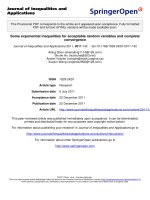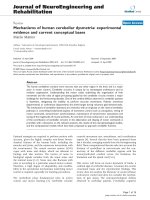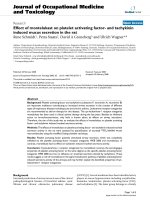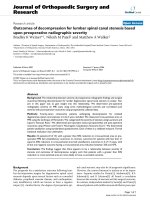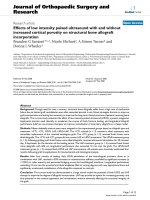Báo cáo hóa học: " Revelation of graphene-Au for direct write deposition and characterization" potx
Bạn đang xem bản rút gọn của tài liệu. Xem và tải ngay bản đầy đủ của tài liệu tại đây (1.48 MB, 7 trang )
NANO EXPRESS Open Access
Revelation of graphene-Au for direct write
deposition and characterization
Shweta Bhandari
1
, Melepurath Deepa
2
, Amish G Joshi
1
, Aditya P Saxena
1
and Avanish K Srivastava
1*
Abstract
Graphene nanosheets were prepared using a modified Hummer’s method, and Au-graphene nanocomposites were
fabricated by in situ reduction of a gold salt. The as-produced graphene was characterized by X-ray photoelectron
spectroscopy, ultraviolet-visible spectroscopy, scanning electron microscopy, and high-resolution transmission
electron microscopy (HR-TEM). In particular, the HR-TEM demonstrated the layered crystallites of graphene with
fringe spacing of about 0.32 nm in individual sheets and the ultrafine facetted structure of about 20 to 50 nm of
Au particles in graphene composite. Scanning helium ion microscopy (HIM) technique was employed to
demonstrate direct write deposition on graphene by lettering with gaps down to 7 nm within the chamber of the
microscope. Bare graphene and graphene-gold nanocomposites were further cha racterized in terms of their
composition and optical and electrical properties.
Introduction
Graphene, s tructurally known as a monatomic layer of
allotropic-carbon atoms in a hexagonal honeycomb two-
dimensional l attice system, has always been a potential
candidate for various applications due to its remarkable
structural, physical, and electronic properties [1-9]. The
zero density of state at the Fermi level without an
energy gap offered by graphene, and a linear, rather
than parabolic, energy dispersion around the Fermi level
has been well understood in the past. The material has
also been investigated in a combination with other car-
bon structures to yield composites with superior proper-
ties [10,11].
The composites of metal nanoparticles on graphene
sheets also provide a new way to develop catalytic, mag-
netic, and optoelectronic materials. Moreover, adhesion
of such metal nanoparticles to the graphene prevents
their aggregation in dry state [12]. Recently, Kamat et al.
[13] have used solution-based approach of chemical
reduction of AuCl
4
-
ions in graphene suspensions to
fabricate gold (Au) nanoparticles-graphene hybrid
assemblies. In yet another report, Goncalves et al. [12]
demonstrat ed how presence of o xygen functi onalities at
the graphene surface provides reactive sites for the
nucleation and growth of Au nanoparticles (AuNPs).
These graphene/Au nanocomposites act as potential
substrates for surface-enhanced Raman scattering. Min
et al. [14] have also used a surface-chemistry-based
approach for investigating the influence of sur face func-
tionalization on the growth of Au nanostructures on
graphene thin films by utilizing various pyrene deriva-
tives containing different functional groups.
But in comparison to these reports, the work pre-
sented here highlights a simpler route to obtain stable
Au nanoparticles-graphene nanocomposites. It also
demonstrates the capability of direct labeling on nano-
composite by use of scanning helium ion microscopy
(HIM).
The demonstration of imaging by helium (He) ions is
relatively a new techniqu e to characterize the surfaces at
sub-nanoscale with extraordinary a dditional advantages
of in situ ion lithography, nano-patterning, device proto-
typing, fabrication of quantum dots, beam-induced
chemistry, and milling at nanoscale [15,16]. Such a
diverse usage is possible due to the light mass of the He
ion a nd high speed, which results in smaller i nteraction
volume with the surface layers and therefore in better
resolution and potential milling feature size. From the
perspective of sputtering and patterning, the result is a
reduced proximity effect in the surface layer. The light
ion mass results in low energy transfer and hence a rela-
tively lower sput tering yield compared to gallium.
* Correspondence:
1
National Physical Laboratory, Council of Scientific and Industrial Research,
Dr. K.S. Krishnan Road, New Delhi, 110 012, India
Full list of author information is available at the end of the article
Bhandari et al. Nanoscale Research Letters 2011, 6:424
/>© 2011 Bhandar i et al; licens ee Sprin ger. This is an Open Access article distributed under the terms of the Creative Comm ons
Attribu tion License ( which permits unrestricted use, distribution, an d reproduction in
any medium, provid ed the original work is properly cited.
Exploiting the method of nano-patterning of graphene
with helium ions leads considerable promise for a num-
ber of applications in nanoscale electronics, optoelectro-
nics, and mechanics. It has been emphasized [17-22]
that in an application like high-speed field-effect transis-
tors, there is a strong need for graphene to be patterned
at the nanoscale. Patterned graphene can form complex
extended geomenies and can be readily contacted elec-
trically, yielding a well-controlled connection between
microscale and nanoscale systems and devices.
Experimental section
Hydrogen tetrachloroaurate (HAuCl
4
)waspurchased
from Aldrich (St. Louis, MO, USA). Sodium borohy-
dride (NaBH
4
) was acquired from Merck (Darmstadt,
Germany). Inorganic transparent electrodes of SnO
2
:F-
coated glass (Pilkington, sheet resistance of 1 4 Ω/sq)
were cleaned in a soap solution, 30% HCl solution, dou-
ble-distilled water, acetone, and trichloroethylene (in
that order) prior to use. Deionized water (resistivity ≈
18.2 MΩ cm) obtained through Milli-Q system, nitric
acid (HNO
3
) (Merck), sulfuric acid (H
2
SO
4
)(Merck),
and toluene (Spectrochem, Hyderabad, India)were used
as solvents.
Preparation of acid-functionalized graphene
For acid functionalization of graphene, a solution with
H
2
SO
4
:HNO
3
in a 3:1 volume ratio (12 ml H
2
SO
4
and 4
ml HNO
3
) and 2 g graphite powder was made in a flask
and refluxed at 40°C for 16 h. The resulting solution
was washed with deionized water till the pH was
reduced to 5 or 6. As a result, a black colored solution
of acid-functionalized graphene was obtained.
Preparation of Au-graphene nanostructures
To fabricate Au-graphene nanostructures, Au nanoparti-
cles were synthesized in situ in graphene suspension by
the reduction of gold(III) complex by NaBH
4
. A concen-
trated aqueous solution of 0.4 M NaBH
4
was first mixed
with acid-functionalized graphene suspension in toluene.
With continuous stirring, 30 mM of HAuCl
4
was then
introduced into this suspension. After continuously stir-
red for 1 h, the resulting Au-graphene com posites were
collected by centrifugation and washed with water for
three times.
Characterization techniques
Fourier transform infrared spectra for the films were
recorded in reflection mode with a Perkin Elmer
GX2000 OPTICA spectrophotometer at 28°C, RH ≈
50% to 53%. I-V measurements of films were carried out
on Keithley 238 high-current electromete r characteriza-
tion system. Absorbanc e (A) spectra were recorded in
the 200- to 800-nm wavelength range in a Perkin Elmer
Lambda 25 spectrophotometer (Perkin Elmer, Ferdi-
nand-Porsche-ring, Rodgau, Germany). X-ray photoelec-
tron spectroscopy (XPS) spectra were recorded for the
as-synthesized graphene samples using a Perkin Elmer
1257 model PHI, Maple Grove, Minnesota , 55311 U.S.A
operating at a base pressure of 3.8 × 10
-8
Torr at 300 K
with a non-monochromatized AlK
a
line at 1,486.6 eV,
an analyzer pass energy of 60 eV kept for core level
spectra and a hemispherical sector analyzer capable of
25-meV resolution. The overall instrumental resolution
was about 0.3 eV. The core level spectra were deconvo-
luted using a non-linear iterative least squares Gaussian
fitting procedure. For all fitting doublets, the FWHMs
were fixed accordingly.
Surface morphology of the graphene sheets was stu-
died employing a variable pressure scanning electron
microscopy (SEM), model: Zeiss EVO MA10 Carl Zeiss
SMT AG, Germany. Nanostructural imaging at high
magnifications was carried out using HR-TEM model:
FEI-Tecnai G
2
F 30 STWIN FEI, Achtseweg Noord 5
5651 GG Eindho ven, Netherlands (operated at the elec-
tron accelerating voltage of 300 kV). HR-TEM speci-
mens were prepared by dispersing the graphene films
on copper grid of 3.05 mm in diameter having a 200-
mesh pore size. Further, the surface topography of gra-
phene and graphene-Au composite films was analyzed
by HIM (model: Zeiss ORION Carl Zeiss, NTS Corpora-
tion Way, Peabody MA 01960, U.S.A.). The He ion cap-
ability of the microscope was used to perform the
experiments of nanoscale patterning on the surfaces of
graphene.
Results and discussion
UV-Vis spectral response
The successful synthesis of graphene and Au nanoparti-
cles decorated graphene was confirmed by ultraviolet-
visible (UV-Vis) spectroscopy (Figure 1). The UV-Vis
spectrum of graphene in toluene shows two absorption
peaks, one at 240 nm corresponding to π-π*transitions
of aromatic C-C bonds and the other at 300 nm which
is attributable to n®π* transitions of C=O bonds [23].
When Au nano particles were decorated onto the gra-
phene, a broad peak in the visible range was observed
corresponding t o the surface plasmon a bsorption of Au
nanoparticles. In order to study the effect of graphene
concentration in the synthesis of Au nanoparticles, we
have also synthesized and recorded UV-Vis spectra at
three different concentrations of functionalized graphene
in the bath. As concentration of graphene was increased,
the peak shows a red shift from 528 nm at 0.1 g l
-1
to
545 nm at 0.2 and 0.4 g l
-1
. The quenching in the peak
intensity was also observed which is clearly visible in the
inset of Figure 1. This is probably attributable to the
increase in Au nanoparticle size that further controls
Bhandari et al. Nanoscale Research Letters 2011, 6:424
/>Page 2 of 7
the surface plasmon absorption, with increase in the
concentration of functionalized graphene [24]. Also,
charge transfer from Au nanoparticles to graphene
resulted in a decrease in electron density which even-
tually contributes to the red shift of the surface plasmon
absorption [23]. It is highly probable that this charge
transfer is playing role in the stability of this
nanocomposite.
X-ray photoelectron spectroscopy
The formation of stabilized Au-graphene nanocompo-
site was further confirmed by the XPS spectra as
shown in Figure 2. Various compendia of peak attribu-
tions of C1s and O1s are listed in Table 1. C1s com-
plex envelope is constituted of five contributions
confirming the acid f unctionalizing of the graphene.
Peak at 531.1 eV in O1s spectra owing to C-O-Au
bond confirms the stabilized Au-graphene nanocompo-
site. The N1s peak at 403.5 eV shows clearly the func-
tionalization of graphene by acid treatment. The
signature of Au doublet was found with two distinct
state of Au(4f
5/2
)andAu(4f
7/2
) [25] due t o the spit-
orbit splitting. The binding energy values are somewhat
lower. Similar t rend was observed by Li et al. [23] for
Ag/graphene nanocomposites where the effect was
attributed to electron transfer from Ag to graphene
due to smaller wave function of Ag than graphene
[26,27]. Interaction between Au and C=O of graphene
also contributes to the electron transfer [28], and the
result corroborates with that of UV results. The bind-
ing energy diffe rence between the two states found 3.7
Figure 1 UV-Vis absorption spectra of pure acid-functionalized
graphene and Au-graphene nanocomposites. In toluene
containing different concentrations of functionalized graphene. Inset
shows the magnified view of surface plasmon absorption peaks.
Figure 2 Core level spectra of Au-graphene nanocomposite. With solid lines signifyin g the deconvoluted contributions of (a)C1s,(b)O1s,
(c) Au4f and (d) N1s.
Bhandari et al. Nanoscale Research Letters 2011, 6:424
/>Page 3 of 7
eV, which confirms the Au in charged Au
+
state.
Deconvolution was performed on C(1s), O(1s) and Au
(4f) XPS core spectra are shown in Figure 2. Au(4f)
deconvoluted spectra was composed of four peaks (Fig-
ure 2c). The resolved peaks related to Au
0
(81.8 and
85.3 eV) exhibit the metallic nature of Au, while Au
+
state (83.7 and 87.4 eV) probably due to the interaction
with the negatively charged graphene around Au
induces a positive charge. The contribution of various
spices of core level spectra is listed in Table 1.
Microstructural features induced during synthesis
Crumpled, folded, laye rs of bare graphene can be seen
in the SEM image shown in Figure 3a. The SEM image
of bare graphene displayed in Figure 3b shows stacks
of graphene layers, bound by van der Waals forces.
The thick edges of the sheets therein (inset of Figure
3b) reveal that t he layers are atop e ach other with a
thickness of about 0.45 µm. HR-TEM was employed to
study the graphene and Au-graphene nanocomposites
to investigate the microstructure of graphene as well
as the size, shape, and distribution of Au nanoparticles
in the graphene matrix (Figure 4). A conventional
folded microstructure of thin graphene sheets was
observed throughout the specimen (Figure 4a). The
thickness of these sheets varies between 1 to 2 nm,
whereas the size of these sheets is on an average
between 500 nm to 1 µm (Figure 4a). A significant
observation was made by resolving the graphene sheets
at lattice scale. The magnified regions, marked as A
and B (as indicated in Figure 4b), are displayed in Fig-
ure 4c,d, respectively. Figure 4c exhibits a cluster of
graphene sheets with well-resolved fringes showing the
crystalline nature of individual sheets at lattice scale,
whereas Figure 4d further reveals the lattice fringe spa-
cing of about 0.34 nm from a single sheet of a gra-
phene. A good distribution of Au nanoparticles in the
matrix phase of graphene has been delineated in the
graphene-Au composite materials with a good interface
between the matrix and the nanoparticle. An inset in
Figure 4a exhibits the pre sence of carbon decorated
with ultrafine dispersion of Au nanoparticle in a gra-
phene-Au nanocomposi te. Moreover, a faceted mor-
phology of Au nanoparticle with the edges of about 30
nm clearly shows that the nanoparticle of Au is crys-
talline with preferred orientation (inset in Figure 4a).
Since Au is characterized by a face-centered cubic
crystal structure, the hexagonal-shaped particles are
presumably due to the preferred growth along the 111
planes of a cubic crystal. The 111 planes of Au with
Table 1 Deconvoluted contributions of various core level
spectra present in Au-graphene nanocomposite
Peaks Binding energy
(eV)
Attributions Peak area
(%)
C1s (FWHM =
1.51eV)
284.6 C-C in graphene 54
285.8 C-OH in
graphene
25.4
287.1 C-O-C in
graphene
9.2
288.6 C=O in graphene 5.7
289.9 C(O)O in
graphene
5.7
O1s (FWHM =
1.22eV)
529.3 C(O)O in
graphene
14.6
530.3 C=O in graphene 31.4
531.1 C-O-Au of
composite
27.4
532.0 C=O in graphene 17.8
532.9 C-OH in
graphene
8.8
Au4f (FWHM=
2.03eV)
81.8, 85.3 Au4f (of Au
0
) 41.6
83.7, 87.4 Au4f (of Au
+
) 58.4
*FWHM: Full width at half maximum
Figure 3 SEM images of graphene. Showing (a) an aggregate of
nanosheets and (b) stacks of the sheets. Inset shows the edges of
individual sheets.
Bhandari et al. Nanoscale Research Letters 2011, 6:424
/>Page 4 of 7
graphene of c-axis growth of carbon lattice also justify
a distinct orientation relationship and therefore a crys-
tallographic compatibility between the carbon as
matrix and the Au as second phase.
Nano-patterning on the helium ion microscopy
Nano-patterning by use of a high-resolution microscope
is a fast developing method which facilitates in situ
examination of the microstructure and direct write of
arbitrary patterns on the given nanomaterial. HIM is
showing the capability to create smaller structures than
possible with other technique [ 15-17]. In the present
work, HIM has been employed to write National Physi-
cal Laboratory in Hindi language in Devnagari script in
the form of deposited carbon (Figure 5a). Combining a
high-brightness gas field ion source with unique sample
interaction dynamics, the He ion microscope provides
images with unique contrast and complementary infor-
mation to existing charged particle imaging instruments
such as the SEM and TEM. Formed by a single atom at
the emitter t ip, the He probe can be focused to b elow
0.35 nm offering the highest recorded resolution for sec-
ondary electron images. The small interaction volume
between the helium beam and the sample also resu lts in
images with stunning surface detail. Besides high-resolu-
tion imaging, the collimated beam of He ions can be
manipulated for nano-patterning on even two-dimen-
sional nanostructured materials like graphene. The
unique combination of sub-nanometer high-resolution
surface microscopy and in situ nano-scaled structural
buildi ngs elucidates a new field which is so far relatively
unexplored in fabrication and process c ontrol of funda-
mentally important nano-objects like graphene. In the
present work, the text ("National Physical Laboratory” in
Figure 4 HR-TEM micrographs of acid-functionalized
grapheme.(a) Sheets with wrinkle contrast, (b) different layers of
graphene and (c, d) lattice scale fringes of graphene resolved from
two different regions as marked A and B in (b).
Figure 5 He ion microscopy. Showing (a) nano-patterning by direct write deposition and (b) distribution of gold particles marked with a set of
arrows in graphene.
Bhandari et al. Nanoscale Research Letters 2011, 6:424
/>Page 5 of 7
Hindi language) was created by deposition of carbon.
This pattern, in the form of a bitmap, was opened up in
Orion software Carl Zeiss NTS LLC, 1 Corporation
Way, Peabody MA 01960, U.S.A. Subsequent ly, the user
defined the size of the overall pattern, and the pixel size
was scaled accordingly. The ion dose per pixel was also
var iable, being set in proportion to the gray lev el in the
bitmap (up to 256 levels). Lettering with gaps down to 7
nm was observed. In this process, the direction of scan-
ning was also user selectable. In another set of experi-
ments, HIM was used to study the distribution of Au in
the matrix of graphene (Figure 5b). We have noticed
that spherical Au nanoparticles of size in the range of
20 to 50 nm are uniformly distributed in the matrix. A
thin layer of graphene on the surface of individual Au
nanoparticles is also inferred due to th e presence of a
glazy contrast on Au surfaces. It is important to men-
tion that there is no deterioration at the boundaries
between the matrix and the second phase.
Electrical properties
The I-V characteristics of Au-graphene and functiona-
lized graphene were recorded in the following configura-
tion: SnO
2
:F/Au-graphene/aluminum as shown in Figure
6 where respective solutions were drop casted on the
SnO
2
:F-coated glass substrates. The AuNPs decoration
was having a beneficial effect on the electronic conduc-
tivity of gra phene. Both the films show ohmic contact
with the substrate in 0 to +1 V potential region as can
be seen from the linear variation of current with applied
bias. For the Au-graphene composite, the conductivity
was determined to be 0.49 S cm
-1
which is much higher
than blank functionalized graphene fil m where the value
was estimated to be 0.07 S cm
-1
which validates the role
of interaction with AuNPs in the enhancement of con-
ductivity. In the literature, the value of pristine graphene
has been reported to be 0.2 S c m
-1
[9]. Here, probably
due to functionalization, the value is lower. In Au-gra-
phene, enhanced coupling occurred between AuNPs as
they attached themselves onto the defect sites of gra-
phene surface, hereby increasing the charge transfer
between the two. Functional groups present on t he gra-
phene sheets served as anchors for adsorption of nano-
particles and the positively charged AuNPs as depicted
earlier in XPS could easily adsorb on these negative
sheets through electrostatic attraction. Moreover, e ven
the inherent electronic c onductivity of the metal NPs
are higher and all these attribute to the increased con-
ductivity in the Au-graphene nanocomposite.
Conclusion
A simple modified Hummer’s method was used to fabri-
cate graphene and graphene-Au nanocomposites. A signif-
icant change in I-V characteristics between bare graphene
and its Au incorporated nanocomposites has been noticed.
An important in situ direct write deposition on nanosheets
of graphene has been demonstrated by employing He ions
inside the chamber of the microscope.
Acknowledgements
The authors thank the Director, NPL, New Delhi for his guidance and
encouragement. One of the authors (AKS) acknowledges the CSIR travel
grant to visit USA in February 2010. M/S Carl Zeiss NTS (USA) is gratefully
acknowledged for extending the facility of helium ion microscopy to carry
out the experiments of nano-patterning. Mr. K. N. Sood is acknowledged for
SEM measurements.
Author details
1
National Physical Laboratory, Council of Scientific and Industrial Research,
Dr. K.S. Krishnan Road, New Delhi, 110 012, India
2
Department of Chemistry,
Indian Institute of Technology Hyderabad, Hyderabad, 502205, India
Authors’ contributions
SB carried out the graphene preparation and interpretation of results. MD
did the lectrical measurements. AGJ carried out XPS measurements and
interpretations. APS assisted in synthesis of material. AKS initiated the idea of
working on present topic and subsequently compiled the data.
Competing interests
The authors declare that they have no competing interests.
Received: 9 December 2010 Accepted: 15 June 2011
Published: 15 June 2011
References
1. Hermando DH, Guinea F, Bratas A: Spin-orbit coupling in curved
graphene, fullerenes, nanotubes, and nanotube caps. Phys Rev B 2006,
7:155426.
2. Wallac PR: The band theory of graphite. Phys Rev 1947, 71:622.
3. Eda G, Fanchini G, Chhowalla M: Large-area ultrathin films of reduced
graphene oxide as a transparent and flexible electronic material. Nature
2008, 3:270.
4. Slonczewski JC, Weiss PR: Band structure of graphite. Phys Rev 1958,
109:272.
5. Vincenzo DPD, Mele EJ: Self-consistent effective-mass theory for
intralayer screening in graphite intercalation compounds. Phys Rev B
1984, 29:1685.
6. Pasricha R, Gupta S, Srivastava AK: A facile and novel synthesis of Ag-
graphene-based nanocomposites. Small 2009, 5:2253.
Figure 6 I-V characteristics of Au-graphene and blank acid-
functionalized graphene.
Bhandari et al. Nanoscale Research Letters 2011, 6:424
/>Page 6 of 7
7. Hicks J, Behnam A, Ural A: A computational study of tunneling-
percolation electrical transport in graphene-based nanocomposites. Appl
Phys Lett 2009, 95:213103.
8. Rafiee MA, Lu W, Thomas AV, Zandiatashbar A, Rafiee J, Tour JM,
Koratkar NA: Graphene nanoribbon composites. ACS Nano 2010, 4:7415.
9. Xu Y, Wang Y, Liang J, Huang Y, Ma Y, Wan X, Chen Y: A hybrid material
of graphene and poly (3,4-ethyldioxythiophene) with high conductivity,
flexibility, and transparency. Nano Res 2009, 2:343.
10. Xie SH, Liu YY, Li JY: Comparison of the effective conductivity between
composites reinforced by graphene nanosheets and carbon nanotubes.
Appl Phys Lett 2008, 92:243121.
11. Wassei JK, Tung VC, Jonans SJ, Cha K, Dunn BS, Tang Y, Kaner RB:
Stenciling graphene, carbon nanotubes, and fullerenes using
elastomeric lift-off membranes. Adv Matter 2010, 22:897.
12. Goncalves G, Marques PAAP, Granadeiro CM, Noguiera HIS, Singh MK,
Gracio J: Surface modification of graphene nanosheets with gold
nanoparticles: the role of oxygen moieties at graphene surface on gold
nucleation and growth. Chem Mater 2009, 21:4796.
13. Muszynski R, Seger B, Kamat PV: Decorating graphene sheets with gold
nanoparticles. J Phys Chem C 2008, 112:526.
14. Kim Y-K, Kyung Na H, Min D-H: Influence of surface functionalization on
the growth of gold nanostructures on graphene thin films. Langmuir
2010, 26:13065.
15. Bell DC: Contrast mechanisms and image formation in helium ion
microscopy. Microsc Microanal 2009, 15:147.
16. Bell DC, Lemme MC, Stern LA, Williams JR, Marcus CM: Precision cutting
and patterning of graphene with helium ions. Nanotechnology 2009,
20:455301.
17. Lemme MC, Bell DC, Williams JR, Stern LA, Baugher BWH, Jarillo-Herrero P,
Marcus CM: Etching of graphene devices with helium ion beam. ACS
Nano 2009, 3:2674.
18. Sidorkin V, Veldhoven EV, Drift EVD, Alkemade P, Salemink H, Maas D: Sub-
10-nm nanolithography with a scanning helium beam. J Vac Sci Technol
B 2009, 27:L18.
19. Winston D, Cord BM, Ming B, Bell DC, Natale WFD, Stern LA, Vladar AE,
Postek MT, Mondal MK, Yang JKW, Berggren KK: Scanning-helium-ion-
beam lithography with hydrogen silsesquioxane resist. J Vac Sci Technol
B 2009, 27:2702.
20. Alkemade P, Sidorkin V, Chen P, Drift EVD, Langen AV, Maas D,
Veldhoven EV, Scipioni L: Helium ion beam processing for nano-
fabrication and beam-induced chemistry. Microscopy Analysis
New York:
Wiley; 2010, 5.
21. Zhou Y, Loh KP: Making patterning on graphene. Adv Mater 2010, 22:3615.
22. Bell DC, Lemme MC, Stern LA, Marcus CM: Precision material modification
and patterning with He ions. J Vac Sci Technol B 2009, 27:2755.
23. Li J, Liu C-Y: Ag/graphene heterostructures: synthesis, characterization
and optical properties. Eur J Inorg Chem 2010, 1244.
24. Henglein A: Reduction of Ag(CN)2- on silver and platinum colloidal
nanoparticles. Langmuir 2001, 17:2329.
25. Brust M, Walker M, Bethell D, Schiffrin DJ, Whyman R: Synthesis of thiol-
derivatised gold nanoparticles in a two-phase liquid-liquid system. J
Chem Soc Chem Commun 1994, 7:801.
26. Lopez-Salido I, Lim DC, Dietsche R, Bertram N, Kim YD: Electronic and
geometric properties of Au nanoparticles on Highly Ordered Pyrolytic
Graphite (HOPG) studied using X-ray Photoelectron Spectroscopy (XPS)
and Scanning Tunneling Microscopy (STM). J Phys Chem B 2006, 110:1128.
27. Wu XJ, Zeng XC: Periodic graphene nanobuds. Nano Lett 2009, 9:250.
28. Deng ZW, Chen M, Wu LM: Novel method to fabricate SiO
2
/Ag
composite spheres and their catalytic, surface-enhanced Raman
scattering properties. J Phys Chem C 2007, 111:11692.
doi:10.1186/1556-276X-6-424
Cite this article as: Bhandari et al.: Revelation of graphene-Au for direct
write deposition and characterization. Nanoscale Research Letters 2011
6:424.
Submit your manuscript to a
journal and benefi t from:
7 Convenient online submission
7 Rigorous peer review
7 Immediate publication on acceptance
7 Open access: articles freely available online
7 High visibility within the fi eld
7 Retaining the copyright to your article
Submit your next manuscript at 7 springeropen.com
Bhandari et al. Nanoscale Research Letters 2011, 6:424
/>Page 7 of 7
